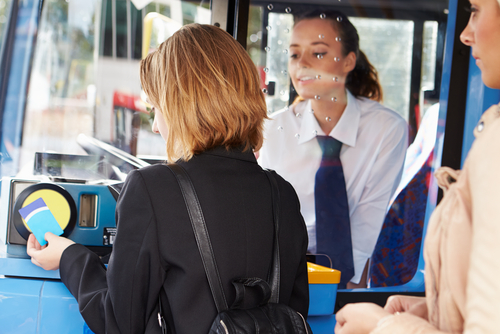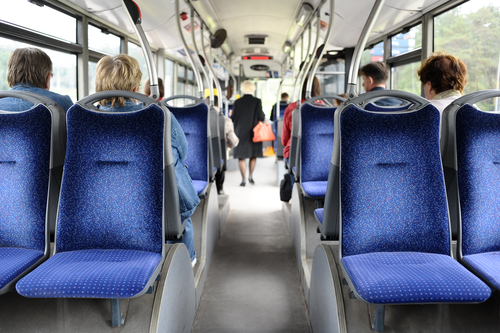Take the Bus
If you live in an area with convenient bus service, you can save money while reducing air and climate pollution.
Your Impact
Action Steps & Tips
Introduction

Cars are convenient. But depending on where you live, you may find the bus is an even better way to get around for some trips. Good bus service does not exist everywhere, but this is changing. More and more companies are offering bus service to employees for commuting and many cities are looking to expand bus service as part of sustainability plans.
Taking the bus can save money while also reducing climate and air pollution. The cost of driving a car has gone up to $.80 per mile for the average driver. Riding the bus typically costs around $1-3 per trip, or generally $.40-$.60 per mile. That’s a big savings. Even better, you can relax, read or work while in transit — something you can’t do when you are behind the wheel.
Taking the bus:
-
Can save money on your commute
-
Reduces climate and air pollution
-
Gives you time to relax and catch up with friends or read a book along the way!
1Check schedules and plan ahead
A bit of advance planning can make your bus trip go smoothly.
Check out the bus routes. Plan your trip! Check out the websites or apps for your local bus service to find the best route to get you where you need to go.
Try a trip planning app. If available, use the trip planning feature on your local bus service website or using Google Maps. Simply put in your starting location and destination and get instructions for what buses to take including any transfers. If using Google Maps, select the Transit option instead or private car.
Walk or bike to the bus stop. Look for a low impact way to get to the bus station. If the bus stop is close, consider walking or biking. Most buses accommodate bikes, often with a bike rack. If you don’t know how to use the bike rack, look at the bus website for information or ask the bus driver for help. Most buses also accommodate disabled riders and wheelchairs. If you need to drive, look for parking options and fees.
Check on the fare. If you are only taking the bus occasionally, you will probably want to pay for each ride. Make sure you have exact change or a transit card since bus drivers typically cannot make change for you.
If you plan to ride the bus often, getting a bus pass can save a lot of money. Many companies will pay for bus passes for employees. Most buses also give discounts for students, the elderly or disabled persons. Check your pass for other options—it might work for other local public transport systems like the train.
2Go for a ride
Taking the bus is easy. Here are a few tips for your trip:
Arrive early. Be at the bus stop at least a few minutes early.
Check the sign. Before you board the bus, check to make sure you are getting on the right bus. Buses have digital signs on the front or side indicating the destination and the route number. Once you are onboard, keep watch to make sure you know where you are and don’t miss your stop. If you’re not sure, don’t be afraid to ask the bus driver or other passengers for help.
Telling the driver when to stop. Usually, there is a cord to pull or button to push to request a stop. Push this early enough to give the driver time to stop.
Be aware and don’t forget your stuff. It’s a good idea to be aware of your surroundings and keep your belongings close. Don't forget them when you get off! It will likely be hard to get anything back that you leave on the bus. If you like to listen to music, keep one earbud in and one out so you can hear your stop announced or any directions from the bus driver.
Relax and enjoy the ride. Catch up on reading a good book, check your email or relax and listen to music — all while reducing climate and air pollution!


